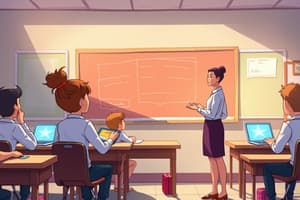Podcast
Questions and Answers
What are the goals of misbehavior?
What are the goals of misbehavior?
- Revenge (correct)
- Avoidance of failure (correct)
- Attention (correct)
- Power (correct)
What is the purpose of Tier 1 in behavior interventions?
What is the purpose of Tier 1 in behavior interventions?
Preventions and interventions for all behavior types
What format should verbal statements with escalating consequences follow?
What format should verbal statements with escalating consequences follow?
please statement n target stop do format
How often should data be examined in intensive progress monitoring?
How often should data be examined in intensive progress monitoring?
Match the types of learning with their descriptions:
Match the types of learning with their descriptions:
What are screening measures used for?
What are screening measures used for?
The SSBD is designed for __________.
The SSBD is designed for __________.
What indicators are considered in the screening measures?
What indicators are considered in the screening measures?
What are 3 styles of classroom management?
What are 3 styles of classroom management?
What does the Hands off style of classroom management mean?
What does the Hands off style of classroom management mean?
What does the 'hands on' style of classroom management mean?
What does the 'hands on' style of classroom management mean?
What does the 'hands joined' style of classroom management mean?
What does the 'hands joined' style of classroom management mean?
When a teacher is faced with a misbehaving student, what type of body language should the teacher present?
When a teacher is faced with a misbehaving student, what type of body language should the teacher present?
All students need to feel as if they __________.
All students need to feel as if they __________.
What is meant by the 'Three C's'?
What is meant by the 'Three C's'?
What 3 factors affect students' ability to satisfy the Three C's?
What 3 factors affect students' ability to satisfy the Three C's?
The implementation of the Three C strategies is called the ____________.
The implementation of the Three C strategies is called the ____________.
____________ is the most powerful tool a teacher possesses.
____________ is the most powerful tool a teacher possesses.
When students feel good about themselves and their ability to succeed, what do they believe about themselves?
When students feel good about themselves and their ability to succeed, what do they believe about themselves?
What leads to unfulfilled needs?
What leads to unfulfilled needs?
What is inclusion?
What is inclusion?
What are the 4 goals of a student's misbehavior and who was it originally created by?
What are the 4 goals of a student's misbehavior and who was it originally created by?
What are the two types of attention-seeking behavior?
What are the two types of attention-seeking behavior?
Describe active attention seeking.
Describe active attention seeking.
Describe passive attention seeking behaviors.
Describe passive attention seeking behaviors.
How may one identify attention-seeking behavior?
How may one identify attention-seeking behavior?
What is the 'silver lining' to students who possess attention-seeking behaviors?
What is the 'silver lining' to students who possess attention-seeking behaviors?
What are the 2 principles of preventing attention-seeking behavior?
What are the 2 principles of preventing attention-seeking behavior?
List 7 strategies to choose from as an intervention to attention-seeking behavior.
List 7 strategies to choose from as an intervention to attention-seeking behavior.
Students with active power-seeking behaviors display what type of characteristics?
Students with active power-seeking behaviors display what type of characteristics?
Students with passive power-seeking behaviors display what type of characteristics?
Students with passive power-seeking behaviors display what type of characteristics?
How do you distinguish passive power seekers' disabilities from passive power seeking?
How do you distinguish passive power seekers' disabilities from passive power seeking?
Clues to identify a power seeker include:
Clues to identify a power seeker include:
What is the 'silver lining' to a power seeker?
What is the 'silver lining' to a power seeker?
What are 3 principal ways of preventing power-seeking behavior?
What are 3 principal ways of preventing power-seeking behavior?
What are the characteristics of active revenge-seeking?
What are the characteristics of active revenge-seeking?
What are passive revenge-seeking characteristics?
What are passive revenge-seeking characteristics?
How do you identify revenge-seeking behavior?
How do you identify revenge-seeking behavior?
What is the revenge seeker's 'silver lining'?
What is the revenge seeker's 'silver lining'?
What are the principles of prevention for revenge seekers?
What are the principles of prevention for revenge seekers?
Describe the 3 general stages of a power and revenge seeker acting as 'volcanoes'.
Describe the 3 general stages of a power and revenge seeker acting as 'volcanoes'.
What are 5 things a teacher can do to personally prepare for a revenge or power seeker?
What are 5 things a teacher can do to personally prepare for a revenge or power seeker?
What are ways to intervene during the rumbling stage of revenge or power seekers?
What are ways to intervene during the rumbling stage of revenge or power seekers?
During the eruption stage, what strategies can you use for intervention?
During the eruption stage, what strategies can you use for intervention?
What are the guidelines for effective consequences at the resolution stage of power and revenge seekers?
What are the guidelines for effective consequences at the resolution stage of power and revenge seekers?
When selecting consequences after the resolution stage, what are the 4 categories to choose from?
When selecting consequences after the resolution stage, what are the 4 categories to choose from?
What are the characteristics of an active avoidance of failure behavior?
What are the characteristics of an active avoidance of failure behavior?
What are the characteristics of a passive avoidance of failure behavior?
What are the characteristics of a passive avoidance of failure behavior?
How can you identify avoidance of failure behavior?
How can you identify avoidance of failure behavior?
What is the silver lining in avoidance of failure behavior?
What is the silver lining in avoidance of failure behavior?
What are the principles of prevention of avoidance of failure behavior?
What are the principles of prevention of avoidance of failure behavior?
What are the strategies used for intervention of avoidance of failure?
What are the strategies used for intervention of avoidance of failure?
Define RTI (Response to Intervention).
Define RTI (Response to Intervention).
Define routines.
Define routines.
Define procedures.
Define procedures.
What are the 4 critical assumptions in the 3 Tier Model?
What are the 4 critical assumptions in the 3 Tier Model?
Teachers who are effective managers provide effective instruction by doing what?
Teachers who are effective managers provide effective instruction by doing what?
What are some guidelines for creating classroom rules?
What are some guidelines for creating classroom rules?
How do you clarify expectations (rules, routines, procedures)?
How do you clarify expectations (rules, routines, procedures)?
Describe the 3 tiers.
Describe the 3 tiers.
Flashcards are hidden until you start studying
Study Notes
Classroom Management Styles
- Three styles: Hands off, Hands on, Hands joined.
- Hands off is permissive, lacking clear boundaries or interventions, allowing poor behavior.
- Hands on is autocratic; attempts to enforce behavior often lead to rebellion among students.
- Hands joined promotes a democratic environment where students are treated as decision makers, fostering cooperation and academic achievement.
Importance of Body Language
- Teachers should maintain an unimpressed, businesslike demeanor during misbehavior.
- Calm and firm tone alongside relaxed body language signifies teacher control during conflicts.
Student Needs and the Three C's
- All students need to feel they belong.
- The Three C's: capable, connect, contribute.
- Factors affecting satisfaction of the Three C's include teacher-student relationship quality, classroom climate, and structure appropriateness.
Encouragement and Relationships
- The encouragement process implements the Three C strategies.
- Encouragement is recognized as the most powerful tool in teaching.
- Unfulfilled needs can lead to anger and frustration.
Inclusion and Misbehavior Goals
- Inclusion requires students with special needs to be placed in the least restrictive environment.
- Four goals of student misbehavior: attention, power, revenge, avoidance of failure (developed by Dr. Rudolf Dreikurs).
Attention-Seeking Behaviors
- Two types: Active (obvious, disruptive) and Passive (subtle, non-compliant).
- Identifying attention-seeking behavior involves noticing personal annoyance, impulsive reactions, and temporary behavior changes upon verbal intervention.
- Students seeking attention may desire a relationship but struggle to connect positively.
Power-Seeking Behaviors
- Active power seekers display clear, overt defiance; passive power seekers are quietly non-compliant.
- Distinguishing passive power behavior involves recognizing selective compliance.
- Power seekers can exhibit positive traits such as leadership potential and independent thinking.
Revenge-Seeking Behaviors
- Active revenge seekers engage in direct or passive attacks and emotional manipulation.
- Identifying revenge behaviors often involves personal feelings of anger, leading to the desire for punishment.
- Building caring relationships and teaching appropriate emotional expression are essential prevention strategies.
Avoidance of Failure Behaviors
- Active avoidance includes tantrums to evade assignments due to fear of failure, while passive avoidance may involve procrastination or assumed incapacities.
- Personal feelings of concern or frustration indicate potential avoidance behaviors.
- Encouraging a belief in personal capability and fostering friendships can prevent avoidance.
RTI and Classroom Routines
- RTI (Response to Intervention) integrates assessment and intervention to maximize achievement and reduce behavioral issues.
- Routines consist of regular actions supporting classroom management; procedures are for specific events.
Effective Classroom Management
- Critical assumptions for the 3 Tier Model include effective instruction and established expectations.
- Effective managers utilize time efficiently and engage students actively to minimize misbehavior.
- Creating effective classroom rules involves clarity, positivity, and visibility.
Clarifying Expectations
- Clarification involves gaining attention, teaching rules explicitly, checking understanding, practicing, and evaluating.
Tiered Interventions
- Three tiers of behavioral intervention:
- Tier 1 focuses on universal prevention and interventions.
- Tier 2 addresses more specific behavioral issues with clear consequences.
- Tier 3 entails intensive assessments and plans for students with significant challenges.
Learning Types and Screening Measures
- Three types of learning: Frustrational (hardest), Instructional (most effective), Independent (easiest).
- Screening measures assess at-risk students through factors like attendance, academic performance, and socioeconomic status.
Studying That Suits You
Use AI to generate personalized quizzes and flashcards to suit your learning preferences.




